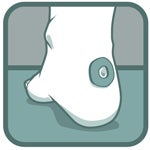Gear School: Crampons
Traverse snow and ice safely with the right set of points.
BUY, USE, FIX| VIDEO: PUTTING ON CRAMPONS | SLIDESHOW: SHARPENING CRAMPONS

BUY
Binding Strap-on bindings (A), the most common system, attach to footwear with nylon webbing. They fit any boot (just make sure the center bar’s flex matches your boot’s flex) and work well on a variety of conditions–but aren’t as stable on technical terrain and take longer to adjust. Step-in bindings (B) must be used with stiff boots that have welts (or grooves) at the toe and heel. They provide excellent stability on the steepest pitches and are easy to adjust while wearing gloves, but can only be used with the most technical mountaineering boots. Newmatic (or hybrid) bindings (C) combine features of the other two types: They have a toe strap and a rear clamp that fits into a boot’s heel welt. They’re easy to put on and give more stability than strap-on bindings, but they require fairly stiff boots; they’ll be overkill for easy glacier travel.
Fit A sloppy interface can mean injury if you lose your footing. Bring in your boots when shopping, and adjust the center bar to fit your boots’ length. The boot should fit the crampon frame snugly before you tighten the straps. Choose a rigid strap-on or newmatic model for hiking and mountaineering boots unless they require a step-in system. “People sometimes try to jury-rig the fit by cutting grooves into their hiking boots, but it never works,” says Matt Fetbrod, a fitter at Neptune Mountaineering in Boulder, Colorado.
Accessories Wear gaiters to protect pants (and flesh) from the sharp points. Get a separate crampon case or rubber point covers to protect your pack when stowing the crampons. Have large or small feet, or boots with rounded soles? Customize the fit by switching out the center bar for a shorter, longer, or curved replacement; they can be ordered from most shops (about $25 a pair).
USE
Wear crampons on slick and steep terrain, but remove them in deep snow (the points can’t bite into powder) and when hiking across long stretches of rock. Hard ground will wear down the points.
When climbing slopes of less than 45 degrees, walk normally–but deliberately. Widen your stance to keep points from snagging your cuffs. High-step slightly and soften your ankle so all points bite into the snow. When kicking steps into steep slopes, let the front points bite into the hill, balance your weight over your toes, and step up.
When traversing a slope, stomp your feet with each step to flatten a platform. On hard-packed snow, angle your feet slightly downhill and cross your feet over each other as you walk forward, making sure that all of your points grip the snow.
Never try to glissade while wearing crampons: You risk serious injury (to yourself and others) if you lose control.
FIX
Bent points? Hammer them back into shape–but remember that the metal has weakened and will eventually break. Save once-bent crampons for snowfields and glacier travel, not technical climbing.
Repair a broken binding in the field by making a substitute strap out of a plastic zip tie, a 6mm accessory cord, or a ski strap.
Always dry crampons before storing to prevent them from rusting.
PHOTO TUTORIAL: Sharpen Your Crampons
Dull points? Learn how to sharpen your crampons for your next trip in no time.
